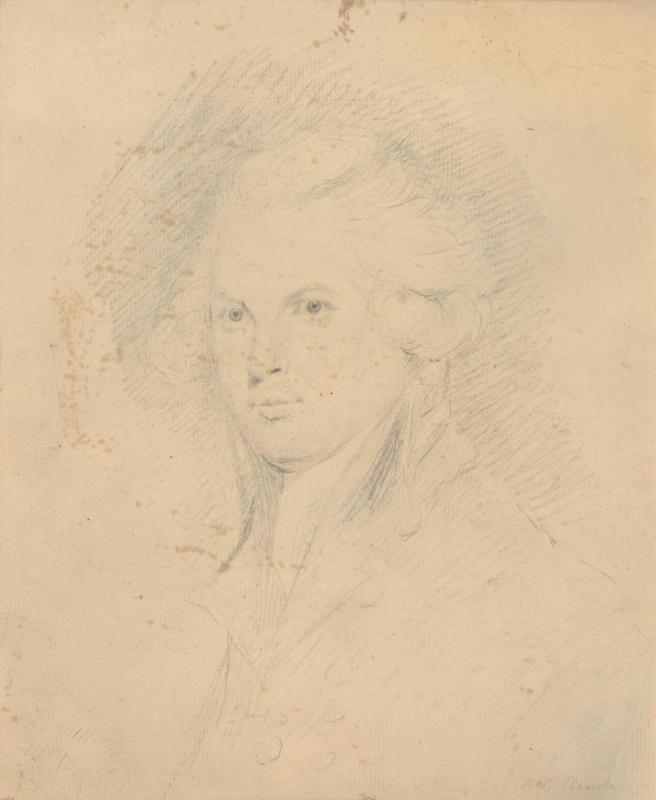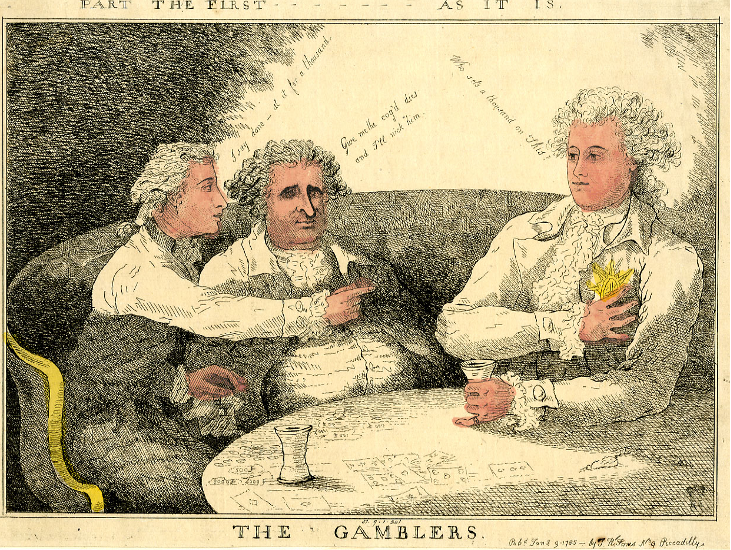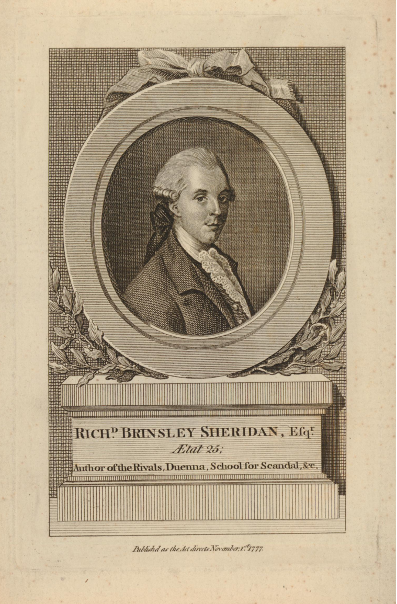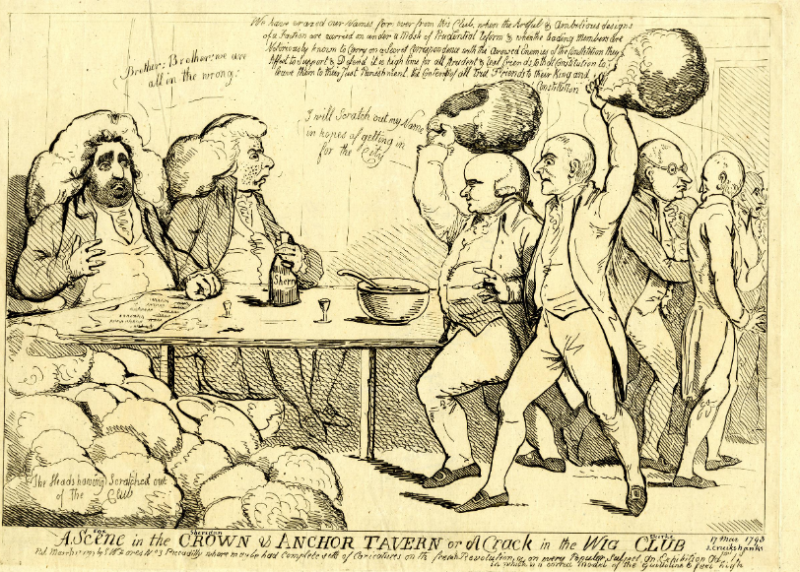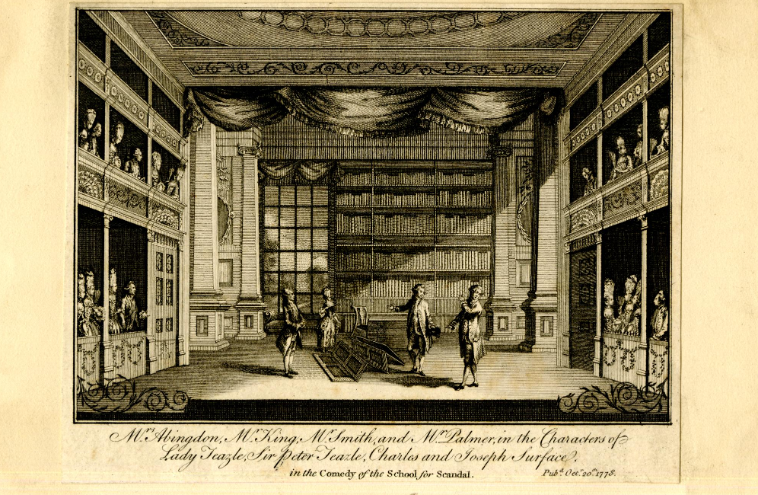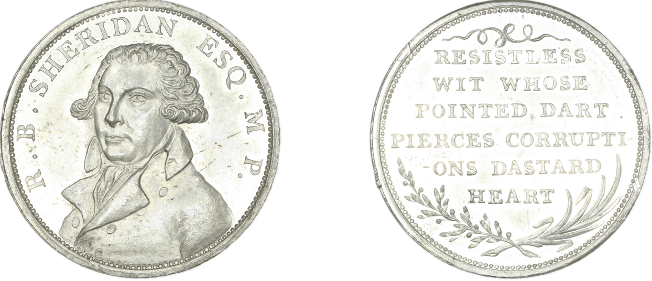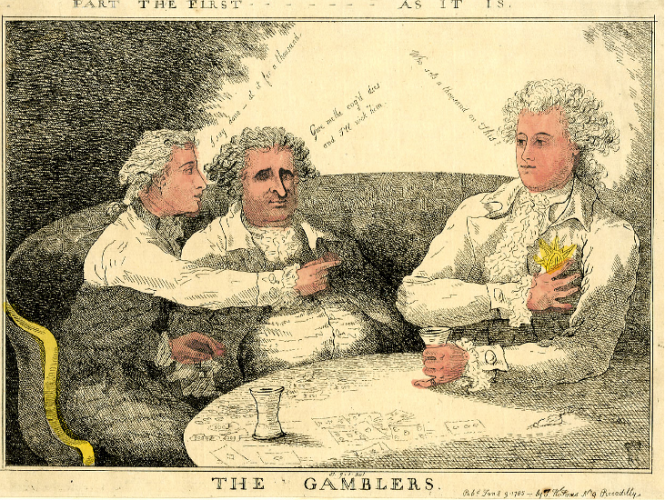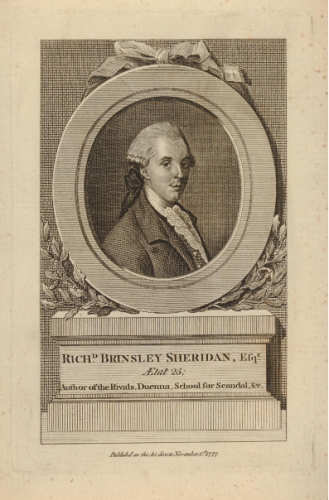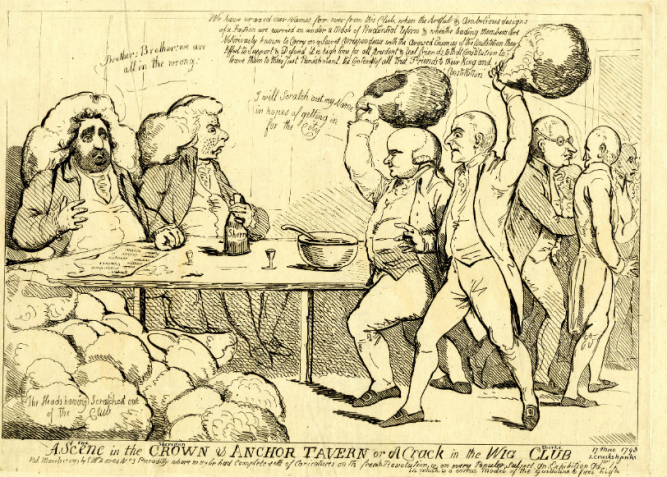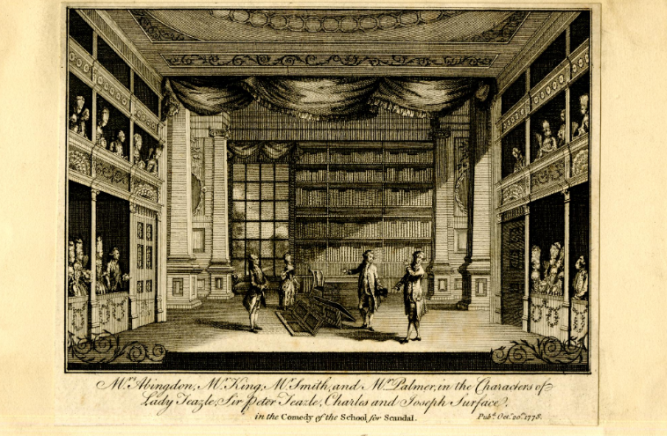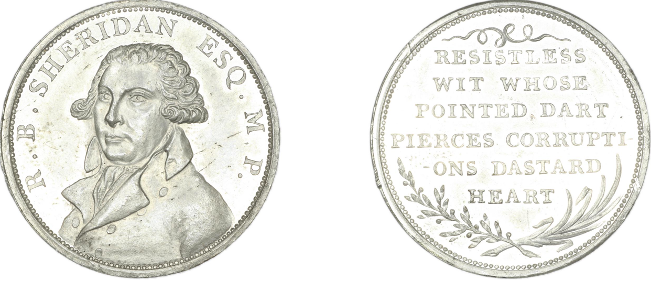Abstract
Richard Brinsley Butler Sheridan (30 October 1751, Dublin, Ireland – 7 July 1816, London, England) was an Irish-born British playwright, poet, politician, 'clubbable' orator and owner of the London Theatre Royal, Drury Lane. He is known for his plays such as The Rivals (1775), The School for Scandal (1777), The Critic (1779) or Pizarro (1799). He moved from the stage to the political arena and was a Whig MP for thirty-two years in the British House of Commons for Stafford (1780–1806), Westminster (1806–1807), and Ilchester (1807–1812). He was a member of Samuel Johnson’s exclusive Literary Club as well as Brooks's Club, the fashionable 'Whig fraternity'.
Keywords
Richard Brinsley Sheridan was part of the late eighteenth-century London male-dominated world of English clubs. A favourite in society, he was ‘clubbable’, to use the term coined by Samuel Johnson and he was also known for drinking heavily and gambling.1 He was a great socializer, using conversation as a social art and political tool and was a member of several London Clubs, such as Samuel Johnson’s exclusive Literary Club (founded in 1764 by the painter Sir Joshua Reynolds around the writer and lexicographer Dr. Samuel Johnson) as well as Brooks's Club, the fashionable 'Whig fraternity'.2
- 1. See Valérie Capdeville, ‘Clubbability: A Revolution in London Sociability?’, Lumen (vol. 35, 2016), p. 63-80, and Valérie Capdeville, ‘Noise and Sound Reconciled: How London Clubs Shaped Conversation into a Social Art’, Études Épistémè (vol. 29, 2016), [En ligne] http://episteme.revues.org/1208
- 2. Sheridan was 'elected to Brooks’s Club, the fashionable Whig fraternity' on November 2, 1780, see Michael Cordner, Richard Brinsley Sheridan, The School for Scandal and Other Plays (New York: Oxford University Press, 1998), p.lvi.
For Lord Byron, Sheridan was the epitome of the London socializer:
‘In society I have met Sheridan frequently: he was superb! […] I have met him in all places and parties—at Whitehall with the Melbournes, at the Marquis of Tavistock’s, at Robins’s the auctioneer’s, at Sir Humphrey Davy’s, at Sam Rogers’s, in short, in most kinds of company, and always found him very convivial and delightful.’3
- 3. Thomas Moore, Letters and Journals of Lord Byron, 2 vols. (London: John Murray, 1830), p. 398.
Lord Byron would add in his Journals, recalling Sheridan’s propensity for drinking, ‘Let me begin the evening with Sheridan [...] Sheridan for dinner […] Sheridan for claret or port […] Sheridan was a grenadier company of lifeguards’ ; ‘Sheridan’s humour, or rather wit, was always saturnine, and sometimes savage’ (Moore, Letters of Lord Byron, 400) and exemplified the best sociable company. In his Monody on the Death of the Right Honorable R. B. Sheridan, Byron portrayed him as a bard and man of wit and social eloquence whose likeness in societies will never be found again.
‘Ye Bards! To whom The Drama’s muse is dear,
He was your Master – emulate him here!
Ye men of wit and social eloquence!
He was your brother – bear his ashes hence!
[…]
Long shall we seek his likeness –long in vain,
And turn to all of him which may remain,
Sighing that Nature formed but one such man,
And broke the die – in moulding Sheridan!’4
- 4. Lord Byron, Monody on the Death of the Right Honorable R. B. Sheridan, written at the request of a friend to be spoken at Drury Lane Theatre (London: John Murray, Albemarble Street, 1816). https://www.poetryverse.com/lord-byron-poems/monody-on-the-death-of-the-right-hon-r-b-sheridan
Sheridan achieved fame at a very young age as a playwright,5 a theatre manager, an outstanding orator and a politician and remained a Whig member of Parliament for thirty-two years in the British House of Commons.6 In September 1780, he had become a young MP for Stafford, a prosperous manufacturing borough. In the springtime of life, he understood the importance of sociability as an essential trait to artistic and political effective leadership and influence. He initiated interpersonal bonds and social relationships at his home in London, creating with his wife, Elizabeth Ann Linley Sheridan (1754-1792) a little social circle, entertaining their guests with music and witty conversations. Sheridan’s brilliant social qualities and his connection to his Harrow schoolfellows brought him social and political rewards.7 Through his friendship with Lord John Townshend, he was acquainted to Charles James Fox (1749-1806), the Whig MP and leader of the opposition to William Pitt the Younger’s Tory government. Sheridan joined the Whig fraternity with Fox and William Windham (1750-1810) and Edmund Burke, Dublin-born like him (1729-1797). Sheridan’s sociability (he was smiled on by royalty, being a close friend, in his youth, of George, Prince of Wales, the future regent) and his latter political career made him the unprecedented political subject of more than 500 satirical drawings from the 1780’s onwards, published in London Newspapers and pamphlets. His move from the stage to the political debating House of Commons made him subject to kaleidoscopic criticisms. In the satirical etching, published by S. W. Fores in 1793, Fox and Sheridan sit together with enormous wigs. Sheridan grasps a bottle of 'Sherry' and Fox exclaims ‘Brother: Brother: we are all in the wrong’. Facing them are two wigless Whigs, one is probably Windham, and, in the background, a wigless Edmund Burke turns his back to them as if criticizing their political support to the French Revolution.
- 5. See Richard Brinsley Sheridan, The Dramatic Works of Richard Brinsley Sheridan, ed. Cecil Price, 2 vols. (Oxford: Clarendon press, 1973).
- 6. See Richard Brinsley Sheridan, Speeches of the Late Right Honourable Richard Brinsley Sheridan: Several Corrected by Himself and Edited by a Constitutional Friend, 5 vols. (London: Patrick Martin, 1816).
- 7. See Richard Brinsley Sheridan, Letters of Richard Brinsley Sheridan, ed. Cecil Price, 3 vols. (Oxford: Clarendon Press, 1966).
Sheridan belonged to a family proud of their Irish identity and yet struggling between British and Irish loyalties for Robert Jones.8 His father Thomas Sheridan, the godson of Jonathan Swift, educated at Trinity College Dublin, was a well-known Irish actor and theatre manager of Smock Alley in Dublin, before moving to London with his family and befriending among others David Garrick and Charles Macklin. His mother, Frances (born Chamberlain) was a novelist and playwright. His sister Alicia Le Fanu was also a playwright (The Sons of Erin; or, Modern Sentiments, 1812) and a biographer (Memoirs of the Life and Writings of Mrs. Frances Sheridan, 1824), and his younger sister Elizabeth Sheridan9 was a novelist (The Triumph of Prudence over Passion, 1781).10 The Rivals (1775), a play based on Sheridan’s love story and elopement with Elizabeth Ann Linley and the two duels he fought against Captain Thomas Matthews, was also influenced by his mother’s play A Journey to Bath with the character of Mrs. Tryfort for his Mrs. Malaprop and his father’s bad temper for Jack Absolute’s father. There are numerous malapropisms in the plays which, according to Fintan O’Toole, highlight Sheridan’s entrapment inside his father’s linguistic obsession to teach rhetoric and grammar.11 Richard Brinsley Sheridan was an Irishman on the London stage and a British politician with Anglo-Irish loyalties (supporting the Irish Cause and the French Revolution along with Fox).
- 8. See Robert Jones, ‘Trading Loyalties: Sheridan, The School for Scandal and the Irish Propositions’ in, David O’Shaughnessy (ed.), Ireland, Enlightenment and the English Stage, 1740-1820 (Cambridge: Cambridge University Press, 2019), p. 128-145.
- 9. See Elizabeth Sheridan, Betsy Sheridan’s Journal: Letters from Sheridan’s Sister 1784-1786 & 1788-1790, ed. William Le Fanu (London: Eire & Spottiswoode, 1960).
- 10. Elizabeth Sheridan, The Triumph of Prudence over Passion, ed. Aileen Douglas and Ian Campbell Ross (Dublin: Four Courts Press, 2011).
- 11. See Fintan O’Toole, A Traitor’s Kiss: The Life of Richard Brinsley Sheridan (London: Granta, 1998).
In 1776, he became one of the proprietors of Drury Lane Theatre where The School for Scandal was produced in May 1777. According to Thomas Moore, as a great socializing orator and man of fashion, Sheridan would go out at night or entertain at home and would only accomplish his literary endeavor after midnight at the cost of a bottle of port, or work at sunrise.12 The rehearsal of the play The School for Scandal starting before it was finished, the actors had to wait until five days before the final production to read the last act and learn their parts. But for Thomas Moore, Sheridan worked very hard and for him, it was ‘the fate of Mr. Sheridan […] to gain credit for excessive indolence and carelessness, while few persons, with so much natural brilliancy of talents, ever displayed more art and circumspection in their display’ (Moore, Memoirs of Sheridan).
- 12. See Thomas Moore, Memoirs of the Life of the Right Honorable Richard Brinsley Sheridan, 2 vols. (London: Longman, Hurst, Rees, Orme, Brown and Green, 1825).
A satire on ostensibly polite society, The School for Scandal is considered one the greatest comedies of manners in the English tongue. It is populated by hypocrites and schemers and filled with dazzlingly witty conversations. Lord Byron recalled in his Journals that Sheridan told him ‘that on the night of the grand success of his School for Scandal, he was knocked down and put into the watch-house for making a row in the street, and being found intoxicated by the watchmen’ (Moore, Letters of Lord Byron). R. B. Sheridan wrote his best plays before he was 30 years of age and from 1780, he devoted his time to his political career and to the management of Drury Lane Theatre. His theatrical and political overlapping commitments nearly made him lose everything on 24 February 1809. He was attending a debate in the House of Commons when he heard that his theatre was on fire. According to Thomas Moore, arriving too late on the scene of the fire rushing from Parliament, he is said to have watched his Drury Lane Theatre burn to the ground at the Piazza Coffee-House, drinking and wittingly remarking ‘A man may surely be able to take a glass of wine by his own fireside’ (Moore, Memoirs of Sheridan).
Richard B. Sheridan was a socializer in the sense that he cherished club life with its spirit of male conviviality and friendship and for its ability to build a literary and political career. To rephrase one of R. B. Sheridan’s most well-known malapropisms from his play The Rivals (1775) Act III, Scene iii, he was ‘the pineapple of politeness’ and sociability. His wit and ‘clubbability’ intermingled theatrical and political societies and cultures in London during the eighteenth century and made him the ‘resistless wit whose pointed dart pierces corruption’s dastard heart’.13
- 13. This inscription: RESISTLESS WIT WHOSE POINTED DART PIERCES CORRUPTIONS DASTARD HEART is to be found on the reverse of a Medal of Richard Brinsley Sheridan, (Pewter medal. Production time: 1781-90). It was issued as political propaganda for one of his election campaigns in Stafford in the late 18th century.
Share
Further Reading
Brown, Michael, The Irish Enlightenment (Cambridge, MA: Harvard University Press, 2016).
Capdeville, Valérie and Kerhervé, Alain (eds.), British Sociability in the Long Eighteenth Century: Challenging the Anglo-French Connection (Woodbridge: Boydell & Brewer, 2019).
Clark, Peter, British Clubs and Societies 1580-1800: The Origins of an Associational World (Oxford: Oxford University Press, 2000).
DeRochi, Jack E. and Ennis, Daniel J. (eds.), Richard Brinsley Sheridan: The Impresario in Political and Cultural Context (Lewisburg: Bucknell University Press, 2013).
Kelly, James and Powell, Martyn J. (eds.), Clubs and Societies in Eighteenth Century Ireland (Dublin: Four Courts Press, 2010).
Winston, James, Drury Lane Journal: Selections from James Winston’s Diaries, 1819-1827, ed. Alfred L. Nelson and Gilbert B. Cross (London: Society for Theatre Research, 1974).
